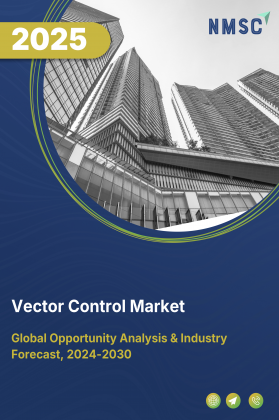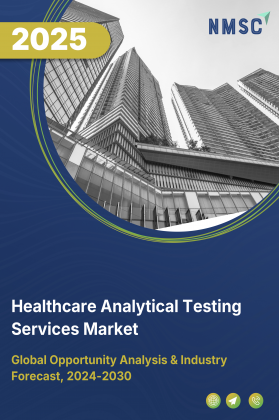
Vector Control Market by Control Method (Chemical, Biological, Physical & Mechanical, Environmental Management & Source Reduction, Integrated Vector Management), by Technology (Chemical-Based, Biological-Based, Mechanical & Physical, Technological Innovations), by Vector Type (Mosquitoes, Flies, Ticks, Others), by Mode of Application (Sprayable, Topical, Systemic, Physical Deployment), by End-User (Residential, Commercial) – Global Opportunity Analysis and Industry Forecast, 2025–2030
Industry Outlook
The global Vector Control Market size was valued at USD 23.69 billion in 2024 and is predicted to reach USD 25.37 billion by the end of 2025. The industry is predicted to reach USD 35.75 billion by 2030 with a CAGR of 7.1% from 2025 to 2030.
The industry is witnessing robust growth driven by the rising incidence of vector-borne diseases such as malaria, dengue, zika, chikungunya, and lyme disease, fuelled by population growth, urbanization, globalization, and climate change. Rapid urbanization and changing climatic conditions create favourable environments for vector proliferation, increasing demand for effective control measures like insecticides, larvicides, traps, and integrated management strategies.
Public awareness campaigns further boost adoption of preventive solutions, while challenges such as rising insecticide resistance constrain the vector control market expansion. Simultaneously, the development of innovative and sustainable technologies, including biological control, genetically modified vectors, AI-driven surveillance, and eco-friendly insecticides, offers new opportunities for growth and market diversification.
Rising Incidence of Vector-Borne Diseases Drives the Market Growth
The rising incidence of vector-borne diseases, including malaria, dengue, zika virus, chikungunya, and lyme disease, is a key driver of the vector control market growth. Factors such as population growth, urbanization, globalization, and climate change have contributed to the wider spread and higher prevalence of these diseases, particularly in tropical and subtropical regions.
This increasing health burden has heightened demand for effective vector control measures, including insecticides, repellents, traps, and integrated management strategies, prompting governments, healthcare organizations, and private sectors to invest heavily in prevention and control programs, thereby driving market growth.
Urbanization and Climate Change Boosts the Market Demand
Rapid urbanization and climate change are major drivers of the vector control market demand, as growing urban populations create environments conducive to the breeding of disease-carrying vectors. According to the World Bank in 2024, the urban population in U.S. accounts for 84% of their total populations, respectively, highlighting the scale of densely populated areas where inadequate sanitation and water management increase vector proliferation.
Additionally, rising temperatures and changing rainfall patterns due to climate change further expand vector habitats and prolong breeding seasons, increasing the risk of vector-borne disease outbreaks and driving demand for effective control measures such as insecticides, larvicides, traps, and integrated management strategies.
Public Awareness and Health Campaigns Fuels Market Expansion
Public awareness and health campaigns play a crucial role in driving the market. As communities become more informed about the health risks posed by vector-borne diseases such as malaria, dengue, and zika virus, there is increased adoption of preventive measures and demand for control solutions.
Government-led initiatives, non-governmental programs, and community outreach campaigns educate people on strategies like proper sanitation, use of insect repellents, mosquito nets, and elimination of stagnant water, which help reduce vector breeding and disease transmission. This growing awareness and proactive participation in prevention efforts significantly boost the adoption of vector control products and services, supporting industry growth.
Rising Insecticide Resistance Among Vectors Limits the Market Growth
A major restraint for the market is the rising insecticide resistance among vectors. Over time, mosquitoes, ticks, and other disease-carrying vectors develop resistance to commonly used chemical insecticides due to repeated and widespread exposure. This resistance diminishes the effectiveness of traditional control methods, leading to higher costs for developing new products and implementing alternative strategies. As a result, the growing challenge of insecticide resistance limits the overall efficiency and expansion of the market.
Adoption of Innovative and Sustainable Control Technologies Creates New Growth Opportunities for the Market
A significant opportunity for the vector control market lies in the development and adoption of innovative and sustainable control technologies. Advances such as biological control methods, genetically modified mosquitoes, AI-powered surveillance, and eco-friendly insecticides offer more effective and environmentally safe solutions for managing vector populations.
Growing government and private sector interest in these next-generation technologies presents opportunities for market players to expand their product portfolios, enter new regions, and meet the rising demand for safer and more efficient vector control solutions.
Market Segmentations and Scope of the Study
The vector control market report is segmented by control method, technology, vector type, mode of application, end-user and region. Control methods include chemical control, biological control, physical and mechanical control, environmental management and source reduction, and integrated vector management combining multiple approaches with surveillance and community engagement. Technologies encompass chemical-based solutions, biological-based solutions, mechanical and physical tools, and digital innovations. Vectors include mosquitoes, flies, ticks, and other species. Applications cover sprayable, topical, systemic, and physical deployment methods, while end users span residential, commercial & industrial, agriculture & horticulture, public health, and healthcare sectors. Geographically, the market is analysed across North America, Europe, Asia-Pacific, and the Rest of the World, reflecting strong and growing demand across diverse regions and industries.
Geographical Analysis
A key driver of the vector control market share in North America is the growing concern over vector-borne diseases, fuelled by the increasing global burden of illnesses such as dengue, West Nile virus, Zika virus, and Lyme disease. According to International Journal of Clinical Pediatrics (IJCP) in 2024, over 7.6 million dengue cases have been reported globally, including 3.4 million confirmed cases, more than 16,000 severe cases, and over 3,000 deaths, highlighting the serious health risks posed by these diseases.
This rising threat has prompted government agencies and private organizations in North America to invest heavily in vector control programs, increasing the adoption of insecticides, repellents, traps, and integrated management strategies, thereby driving market growth.
In Europe, a major driver of the vector control market is the growing investment by governments in public health and vector management programs. European countries are implementing extensive surveillance, prevention, and control measures to address the spread of vector-borne diseases such as West Nile virus, Lyme disease, and chikungunya, which have been rising due to climate change and increased travel.
These initiatives, including advanced vector control technologies, public awareness campaigns, and regulatory support for effective insecticides, are significantly boosting the demand for vector control solutions across the region.
Another important driver of the vector control industry in Asia Pacific is the rapid urbanization and population growth. According to the World Bank in 2024, the urban population in India and China accounts for 37% and 66% of their total populations, respectively, highlighting the scale of densely populated areas prone to inadequate sanitation, poor waste management, and stagnant water that provide ideal breeding grounds for mosquitoes and other vectors. This urban expansion, combined with growing public awareness and government initiatives, has increased the demand for effective vector control solutions, driving market growth in the region.
In the rest of the world (RoW), a key driver of the sector is the increasing adoption of advanced vector control technologies and integrated management strategies. Regions in Africa, Latin America, and the Middle East are witnessing rising incidences of vector-borne diseases such as malaria, dengue, and chikungunya, creating strong demand for innovative solutions.
The use of biological control methods, eco-friendly insecticides, surveillance systems, and genetically modified vectors is gaining traction, supported by government programs and international health initiatives, which is driving the growth of the vector control market, globally.
Strategic Developments in the Boiler Industry
Key players in the vector control industry are actively pursuing product innovation, strategic acquisitions, and international expansion to strengthen their global presence and address emerging challenges.
-
In August 2025, Bell Laboratories acquired by Berkshire Hathaway, continuing to operate independently under its own brand.
-
In April 2025, Syngenta Group launched Sovrenta®, an insecticide offering year-long protection against malaria vectors, addressing resistance issues in regions like sub-Saharan Africa.
-
In September 2024, Rentokil Initial plc opened its first North American Pest Control Innovation Centre in June 2024, aiming to enhance service delivery and develop new solutions for vector control.
Key Benefits
-
The report provides quantitative analysis and estimations of the sector from 2025 to 2030, which assists in identifying the prevailing vector control market opportunities.
-
The study comprises a deep-dive analysis of the current and future vector control market trends to depict prevalent investment pockets in the industry.
-
Information related to key drivers, restraints, and opportunities and their impact on the market is provided in the report.
-
Competitive analysis of the key players, along with their market share is provided in the report.
-
SWOT analysis and Porters Five Forces model is elaborated in the study.
-
Value chain analysis in the market study provides a clear picture of roles of stakeholders.
Vector Control Market Key Segments
By Control Method
-
Chemical Control
-
Insecticides
-
Rodenticides
-
Repellents
-
-
Biological Control
-
Biocontrol Agents
-
Sterile Insect Technique
-
Wolbachia-based methods
-
-
Physical & Mechanical Control
-
Traps
-
Barriers
-
Mechanical removal
-
-
Environmental Management & Source Reduction
-
Habitat modification
-
Water management
-
Waste management
-
-
Integrated Vector Management
-
Combination of multiple methods
-
Surveillance and monitoring
-
Community engagement
-
By Technology
-
Chemical-Based
-
Synthetic insecticides
-
Natural insecticides
-
-
Biological-Based
-
Microbial agents
-
Entomopathogenic fungi
-
Predatory organisms
-
-
Mechanical & Physical
-
Electric traps
-
Mechanical barriers
-
-
Digital & Technological Innovations
-
IoT-enabled sensors
-
Data analytics platforms
-
AI-based surveillance systems
-
By Vector Type
-
Mosquitoes
-
Anopheles
-
Aedes
-
Culex
-
-
Flies
-
Tsetse
-
Sandflies
-
Houseflies
-
-
Ticks
-
Ixodes
-
Rhipicephalus
-
-
Others
By Mode of Application
-
Sprayable
-
Aerosols
-
Foggers
-
Surface sprays
-
-
Topical
-
Creams and lotions
-
Ointments
-
-
Systemic
-
Ingestion
-
Injections
-
-
Physical Deployment
-
Traps
-
Nets
-
Screens
-
By End User
-
Residential
-
Commercial & Industrial
-
Agriculture & Horticulture
-
Public Health & Government
-
Healthcare & Medical Facilities
By Region
-
North America
-
The U.S.
-
Canada
-
Mexico
-
-
Europe
-
The UK
-
Germany
-
France
-
Italy
-
Spain
-
Denmark
-
Netherlands
-
Finland
-
Sweden
-
Norway
-
Russia
-
Rest of Europe
-
-
Asia-Pacific
-
China
-
Japan
-
India
-
South Korea
-
Australia
-
Indonesia
-
Singapore
-
Taiwan
-
Thailand
-
Rest of Asia-Pacific
-
-
RoW
-
Latin America
-
Middle East
-
Africa
-
Key Players
-
Rentokil initial plc
-
sunitomo chemical
-
Syngenta Group
-
Neogen Corporation
-
Envu
-
sc johnson and son
-
JT Eaton
-
Impex Europa SL
-
Abell pest control
-
Bioguard pest solution
-
spotta ltd
-
Massey services
-
Bayer
REPORT SCOPE AND SEGMENTATION:
|
Parameters |
Details |
|
Market Size in 2025 |
USD 25.37 Billion |
|
Revenue Forecast in 2030 |
USD 35.75 Billion |
|
Growth Rate |
CAGR of 7.1% from 2025 to 2030 |
|
Analysis Period |
2024–2030 |
|
Base Year Considered |
2024 |
|
Forecast Period |
2025–2030 |
|
Market Size Estimation |
Billion (USD) |
|
Growth Factors |
|
|
Countries Covered |
28 |
|
Companies Profiled |
15 |
|
Market Share |
Available for 10 companies |
|
Customization Scope |
Free customization (equivalent up to 80 working hours of analysts) after purchase. Addition or alteration to country, regional, and segment scope. |
|
Pricing and Purchase Options |
Avail customized purchase options to meet your exact research needs. |

















 Speak to Our Analyst
Speak to Our Analyst

























